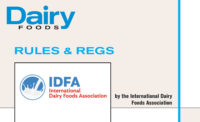The dairy industry, along with the broad food industry, is on its way toward a more traceable supply chain. The FDA’s New Era of Smarter Food Safety Blueprint outlines a goal for the food industry to track and trace foods from farm to fork with the help of computer-based technology. The International Dairy Foods Association (IDFA) has supported the blueprint since its release in July 2020.
However, not all progress is good progress. Stemming from this initiative, the FDA proposed a rule that would impose burdensome recordkeeping requirements for the food industry — and significantly slow the process of traceback investigations.
Establishing plans for traceability
The dairy industry has long been on a path to modernized food safety through tech-enabled traceability, artificial intelligence and digital purchasing. For example, the industry came together in 2009 to create a Guidance for Dairy Product Enhanced Traceability1 and associated Dairy Traceability Checklist2.
The guidance provides several examples of mock recalls and lists 21 key components for an effective traceability system. It considers all potential points of creation, transformation and/or transfer, which provides dairy producers and processors with clear models from which they can build their own traceability systems. This approach and checklist have served the dairy industry well for some time now.
Advocating for ease
Based on the dairy industry’s experience with traceability systems, IDFA’s members are concerned that the FDA’s new proposed rule would impose a restrictive recordkeeping system that is unnecessarily complicated. In response, IDFA submitted comments to FDA, encouraging the agency to simplify the rule to be less prescriptive, restrictive and burdensome for covered entities, which will facilitate more widespread adoption and achieve greater public health benefits.
IDFA is advocating for an outcome-focused (i.e., performance-based) standard that enables covered entities to connect their outgoing product with incoming ingredients and respond to FDA information requests within a particular timeframe.
Looking ahead
With more flexible rules for developing and keeping records, the industry can quickly adopt this new approach – especially smaller entities that don’t have the necessary resources to satisfy FDA’s proposed requirements. You can read the full set of IDFA comments on the IDFA website.
IDFA will continue to work with the FDA to ensure that regulations are flexible and outcome-based, yet effective at moving the food industry forward towards improved traceability.
For more information about the FDA’s new food safety blueprint and its plans for traceability, watch last year’s Regulatory RoundUp Webinar Series, featuring FDA’s director of the Office of Food Safety, Mark Moorman, Ph.D.
Resources
-
Dairy Management Inc. – Innovation Center for U.S. Dairy. Guidance for Dairy Product Enhanced Traceability. Version 3; July 15, 2020.
-
Dairy Management, Inc. – Innovation Center for U.S. Dairy. Dairy Traceability Checklist.

